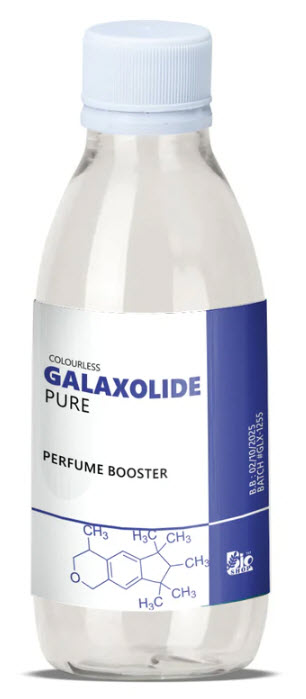Galaxolide is a synthetic musk compound widely used in perfumery for its clean, musky, and long-lasting scent. It is one of the most popular polycyclic musks and is celebrated for its versatility, stability, and ability to enhance the overall structure of a fragrance. Below is a detailed explanation of Galaxolide, including its properties, uses, and significance in perfumery.

1. Chemical Structure and Properties
- Chemical Name: 1,3,4,6,7,8-Hexahydro-4,6,6,7,8,8-hexamethylcyclopenta[g]-2-benzopyran
- IUPAC Name: 1,3,4,6,7,8-Hexahydro-4,6,6,7,8,8-hexamethylcyclopenta[g]-2-benzopyran
- Molecular Formula: C₁₈H₂₆O
- Molecular Weight: 258.40 g/mol
- Appearance: A colorless to pale yellow liquid.
- Odor: Clean, musky, sweet, and slightly floral with a soft, powdery undertone.
- Solubility: Insoluble in water but soluble in alcohol and oils, making it suitable for use in perfumes and cosmetic formulations.
- Boiling Point: Approximately 129°C (264°F) at 0.1 mmHg.
- Stability: Stable under normal conditions but can degrade under strong acids, bases, or UV light.
2. Discovery and Development
Galaxolide was first synthesized in the 1960s by International Flavors & Fragrances (IFF). It was developed as part of the polycyclic musk family, which was created to provide a safer and more environmentally friendly alternative to nitro musks. Galaxolide quickly gained popularity due to its clean, long-lasting, and versatile scent profile.
3. Role in Perfumery
Galaxolide is a versatile fragrance ingredient with several key roles:
- Base Note: It is often used as a base note in perfumes, providing a long-lasting, clean, and musky foundation.
- Blending Agent: It harmonizes well with other musky, floral, and woody notes, creating a balanced and smooth scent profile.
- Fixative: It helps stabilize and prolong the scent of a perfume by slowing down the evaporation of more volatile components.
- Enhancer: It enhances the overall structure of a fragrance, adding depth, warmth, and sensuality.
4. Fragrance Profile
Galaxolide contributes the following olfactory characteristics to a perfume:
- Musky: Adds a soft, warm, and skin-like muskiness.
- Clean: Imparts a fresh, laundry-like cleanness.
- Sweet: Provides a subtle, honey-like sweetness.
- Floral: Enhances floral accords, particularly in white floral and powdery compositions.
- Powdery: Creates a gentle, velvety, and intimate quality.
5. Common Uses in Perfumes
Galaxolide is a staple in many fragrance families, including:
- Floral Fragrances: It is a key component in floral perfumes, particularly those featuring white floral and powdery notes.
- Fresh Fragrances: Its clean and musky qualities make it ideal for fresh and uplifting compositions.
- Oriental Fragrances: Its warm and sweet qualities make it ideal for oriental and amber compositions.
- Functional Fragrances: It is widely used in soaps, detergents, and household cleaners due to its pleasant and long-lasting scent.
6. Safety and Regulation
Galaxolide has been subject to regulatory scrutiny due to concerns about its potential environmental persistence and bioaccumulation. Key points include:
- IFRA Compliance: The International Fragrance Association (IFRA) sets guidelines for the maximum allowable concentration of Galaxolide in different product types to ensure safety.
- Environmental Concerns: Its potential for bioaccumulation and environmental persistence has led to increased scrutiny and the development of more environmentally friendly alternatives.
- Allergen Potential: It is not classified as a significant allergen, but it is always recommended to conduct patch tests to ensure it does not cause adverse reactions in sensitive individuals.
7. Advantages in Perfumery
- Versatility: It blends well with a wide range of fragrance materials, including florals, musks, and woods.
- Longevity: Its fixative properties help prolong the lifespan of a perfume on the skin.
- Clean and Musky Appeal: Its clean and musky qualities make it ideal for creating fresh, modern, and sensual fragrances.
- Cost-Effectiveness: As a synthetic ingredient, it is more affordable than natural alternatives with similar scent profiles.
8. Limitations
- Environmental Concerns: Its potential for bioaccumulation and environmental persistence has led to increased scrutiny and the development of more environmentally friendly alternatives.
- Regulatory Restrictions: Compliance with IFRA and EU regulations may restrict its use in certain formulations.
9. Example Perfumes Featuring Galaxolide
Galaxolide is found in numerous iconic fragrances, including:
- Light Blue by Dolce & Gabbana: Enhances the fresh and musky accords.
- Chanel Chance: Complements the floral and powdery notes.
- Lancôme La Vie Est Belle: Adds warmth and sweetness to the oriental composition.
10. Conclusion
Galaxolide is a fundamental aroma chemical in modern perfumery, prized for its clean, musky, and long-lasting characteristics. Its ability to act as a base note, fixative, and blending agent makes it indispensable in creating fresh, modern, and sensual fragrances. While it is generally safe, its potential environmental impact necessitates careful formulation and adherence to regulatory guidelines. Its versatility and unique scent profile ensure its continued prominence in the fragrance industry.